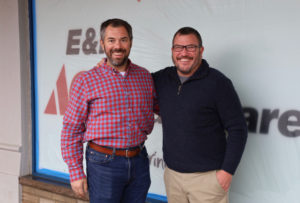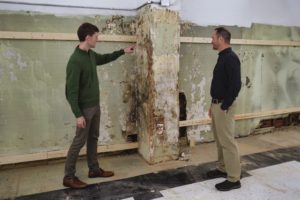Downtown Development, Tradition, and Change!

Matt Long and Chad Boreman, owners of the Quinby Building (1897), new home to Ace Hardware in downtown Wooster.
Downtown Wooster has been reinvesting and revitalizing its downtown for 34 years. A true public/private partnership, more than $215 million of reinvestment and revitalization has occurred since the inception of the Main Street program, beginning in 1987.
In 2015, two former Main Street Wooster board members and subsequent chairs, Matt Long, a local attorney, and Chad Boreman, a local financial planner, formed CBML, Ltd., to acquire and add other community properties.
2018 brought a change for the Quinby Building (1897), a four-story, 26,000 sq. ft. building located on Wooster’s Public Square. Originally occupied as the William Annat Co. Department Store until the 1990’s, the building was most recently the company outlet store for the Newell/Everything Rubbermaid Store.
When the property was listed for sale in 2018, Boreman and Long, generational members of the community (Chad, five and four generations, Matt, three and seven) decided to purchase the building to preserve the “status quo” of the building, keeping the Everything Rubbermaid Store in place, and maintaining Wooster ownership. Long stated, “it was too important of a building to leave to chance”.
Due to the pandemic and revitalization of the 1993 streetscape construction on the Public Square, Newell/Rubbermaid decided to close the large facility in August, 2021 leaving a potential and significant vacancy for downtown Wooster. Long and Boreman made plans to lease “pop-up” stores in the firstfloor retail space (7,500 sq. ft.) while seeking to recruit a long-term tenet; however, early in the planning process, they were approached by Wooster-based E&H Hardware Group, LLC regarding a long-term lease of the entire Quinby Building (1897).
Enter Christopher Buehler and Rich Fishburn, fourth generation, great-grandsons, of Ed and Helen Buehler, who began the Buehler’s grocery chain in 1929 in New Philadelphia, then moving to Wooster where they opened a store in downtown Wooster. Adding stores throughout Ohio, the business is now 92 years young! A hardware company was added, not as a separate company, in 1959, as part of the Orrville, Ohio store.
E&H Hardware group was formed in 2011 as a separate entity from the Buehler’s Fresh Foods grocery chain, opening 25 Ace Hardware stores throughout Ohio. Both Buehler and Fishburn wanted to have a store in their Wooster hometown for years but could not find a space that filled their needs. With Newell announcing the closing of the Everything Rubbermaid Store, Rich went to Christopher and said, “This is it! A perfect building for what we want to do!” The partners envisioned the building as their “flagship store”, a destination for local, regional and tourism customers.

Christopher Buehler & Rich Fishburn looking at uncovered column in the Quinby Building
The E&H partners contacted Long and Boreman and, within a month, executed a lease and created a new partnership to bring a large, new business to the existing downtown retail businesses. (The current hardware store, Tignor’s Hometown Hardware, was purchased by the E&H group: the employees will be a part of the Ace Hardware store when it opens in March, 2022.)
Long and Boreman will have the exterior of the building painted and the Ace Hardware interior will house three floors of hardware, with additional lifestyle- living merchandise including outdoor living, home goods, a dedicated contractor area, The Nook, “a store within a store”, and a plumbing and handyman business. The fourth floor will be the corporate offices of the E&H Hardware Group.
“We want this store to be an anchor for downtown Wooster, we want it to evolve all the time, we want it to complement the downtown and participate in activities with all of the downtown businesses. We will be a “test store” for new and upscale branding of products, introducing new hardware and living products to the customer, yet continuing to offer the products that are “tried and true”, stated Buehler and Fishburn. Boreman and Long said, “This is a “perfect storm”; a traditional business in a traditional downtown, with community development supporting the “sense of place” that is downtown Wooster, Ohio!”
By Sandra C. Hull
This article originally appeared in the Winter 2021 issue of Revitalize Ohio. All rights reserved.
Livable Communities and the AARP Challenge Grants
Wednesday, March 2nd – 1:00 pm – 2:00 pm
The AARP Community Challenge provides small grants to fund quick-action projects that can help communities become more livable for people of all ages. This year, applications will be accepted for projects to improve public spaces, housing, transportation and civic engagement; support diversity, equity and inclusion; build engagement for programs under new federal laws; and pursue innovative ideas that support people age 50 or older.
This presentation will walk through the Community Challenge grant opportunity as well as introduce the concept of livable communities and age-friendly initiatives to the audience.
Our Presenter
 Doug Tayek serves as the Associate State Director for Outreach with AARP Ohio, where his work focuses predominantly on Northeast Ohio; managing a large team of volunteers, Doug is responsible for implementing AARP’s social mission in this area of the state. In 2021 Doug became the statewide lead for Age-Friendly and Livable Communities work for AARP Ohio, supporting his colleagues around the state as they advise and support Ohio’s age-friendly initiatives. Doug currently supports Age Friendly Cleveland, Akron, Summit County, and Athens County; he has also previously worked in support of Age Friendly Columbus/Franklin County, and Age Friendly Delaware County.
Doug Tayek serves as the Associate State Director for Outreach with AARP Ohio, where his work focuses predominantly on Northeast Ohio; managing a large team of volunteers, Doug is responsible for implementing AARP’s social mission in this area of the state. In 2021 Doug became the statewide lead for Age-Friendly and Livable Communities work for AARP Ohio, supporting his colleagues around the state as they advise and support Ohio’s age-friendly initiatives. Doug currently supports Age Friendly Cleveland, Akron, Summit County, and Athens County; he has also previously worked in support of Age Friendly Columbus/Franklin County, and Age Friendly Delaware County.
Doug joined AARP in 2011, he holds a bachelor’s degree from Kent State University, and a master’s degree in Applied Politics from the University of Akron. Doug serves on the board of directors for Cleveland Catholic Charities and Cuyahoga County’s Division of Senior and Adult Services.
Heritage Ohio Annual Awards: How to Submit a Successful Nomination
Wednesday, February 16th – 1:00 pm – 2:00 pm
The 2022 Heritage Ohio Annual Awards nomination period is now open!
Are you proud of the work being done in your community? Do you know someone who has done outstanding revitalization work? Then maybe you want to apply for Heritage Ohio’s statewide awards.
We have 16 award categories to honor the people, organizations, and projects that are making Ohio a better place to live. Want to know more about the award categories and how to submit a successful nomination that will get noticed by the awards committee? Then attend this webinar!
Join Joyce Barrett and Frank Quinn as they introduce the various award categories, and share tips on completing the nomination forms.
Nominations are due by July 1, 2022.
Ohio Arts Council Programs and Grants
Wednesday, January 19th – 1:00 pm – 2:00 pm
The Ohio Arts Council is a state agency that funds and supports quality arts experiences to strengthen Ohio communities culturally, educationally, and economically. OAC has many programs and grants that enhance the arts experience for all Ohioans.
In this webinar, get to know your state arts council! OAC staff will provide a spotlight on Ohio Arts Council grants available to organizations, artists, and schools. They will outline programs, and resources available to the general public, and answer your questions.
This funding is available to every county in the state, to make your community a better place.
Speakers:
Jim Szekacs – Organizational Programs Coordinator for Western and North Central Ohio
Brianna Dance – Organizational Programs Coordinator for the Central and Southeast Ohio.
Patrick Roehrenbeck – Organizational Programs Coordinator
Tax Incentives for Fire Safety Improvements
Wednesday, December 1st – 1:00 pm – 2:00 pm
Did you know there are very generous federal fire safety equipment tax incentives available for existing commercial properties?
This is a financial opportunity to upgrade buildings in your downtown, making them safer for the entire community. This is a path for putting underutilized buildings into more productive use. These incentives enable commercial businesses to expense the full cost of fire safety equipment in one year, rather than depreciating over a long term.
The Tax Cuts and Jobs Act (“TCJA”) was passed in December 2017 and allowed small commercial businesses to accelerate the cost recovery of fire safety equipment by increasing Section 179 expense limitations. The TCJA also eliminated several 15-year asset categories and consolidated them into Qualified Improvement Property (“QIP”).
The CARES (Coronavirus Aid, Relief, and Economic Security) Act corrected a drafting error related to the TCJA that stopped larger businesses from the accelerated cost recovery benefits. The CARES Act assigned a 15-year MACRS depreciation recovery period to QIP and also made them eligible for 100 percent bonus depreciation for property placed in service after September 27, 2019 and before January 1, 2023.
You will learn:
- What improvements qualify as fire safety improvements.
- Which buildings qualify.
- Though you can’t claim historic tax credits while also utilizing the accelerated cost recovery incentives available for fire safety equipment at the same time, you will need to understand each incentive’s strengths and how to determine which is best for your project.
Join Ron Ritchey from the National Fire Sprinkler Association and Tom Boccia and Nick Gerhardt from Novogradac & Company LLP as they explain this opportunity and answer your questions.
This webinar has been approved for 1.0 HSW AIA continuing education credits.
Using the Standards for Rehabilitation to guide your project
Wednesday, December 8, 3:00 pm-4:00 pm
The Secretary of the Interior’s Standards for Rehabilitation consist of 10 common-sense principles to guide and evaluate rehabilitation work done to historic resources. Whether you’re contemplating a future tax credit project or thinking about applying for a historic preservation grant, adhering to the rehab standards will be critical to receiving your final approvals. Join Mariangela Pfister, Department Head, Technical Preservation Services of the State Historic Preservation Office, as she provides a basic overview of the standards and how they are interpreted.
Presenter
Mariangela Pfister, department head and deputy state historic preservation officer for technical preservation services, heads the Technical Preservation Services Department which manages the Building Doctor program, answers questions about care of older buildings, and works with applicants for the Federal Rehabilitation Investment Tax Credit and the Ohio Historic Preservation Tax Credit. She has developed a wood conservation presentation, has written articles on preservation topics, and continues to work on a series of fact sheets entitled “Fast Facts” on common old-building maintenance issues. Pfister holds a master’s degree in history from The Ohio State University and bachelor’s degrees in history, English, and secondary education from Capital University.
COVID-19 Economic Injury Disaster Loans (EIDL)
Rescheduled to Wednesday, December 15th – 1:00 pm – 2:00 pm
Learn how this federal small business loan program supports small businesses’ recovery from the COVID-19 disaster’s economic impacts by providing accessible and borrower-friendly capital. Loans are direct from SBA that must be repaid; low-interest (3.75% business /2.75% non-profit) fixed-rate, 30-year long-term loan to help overcome the effects of the pandemic by providing working capital to meet operating expenses. Use may go toward working capital to make regular payments for operating expenses, including payroll, rent/mortgage, utilities, and other ordinary business expenses, and to pay business debt incurred at any time (past, present, or future).
Presenter
Terry A. Bolden serves as the Deputy District Director for the U.S. Small Business Administration’s Central and Southern Ohio District Office, managing the delivery of the agency’s financial assistance, technical assistance and government contracting activities to customers and stakeholders throughout 60 of Ohio’s 88 counties.
Bolden is a dedicated public servant with over 25 years of an exemplary track record in leadership, business development, infrastructure, and heavy highway transportation. Bolden is recognized as an effective collaborator, creating strategic alliances across the state of Ohio.
In 2020, Bolden joined the SBA after serving in key roles with Federal, State and local government agencies throughout Ohio. Bolden’s previous roles include: Manager for the City of Columbus Mayor’s Office of Diversity and Inclusion; Administrator at the Ohio Department of Transportation (ODOT); Business Advisor for the U.S. Department of Commerce; Compliance Officer with the Northeast Ohio Regional Sewer District; and Construction Inspector with the City of Cleveland Water Department.
A native Clevelander and graduate of Cleveland State University, Bolden has a passion serve his fellow Ohioans achieve prosperity.
Epic Experiences
Wednesday, November 17th – 1:00 pm – 2:00 pm
The Ohio Travel Association has done its research on elevating experiences to a transformative level and is launching an Epic Group Experiences designation program for businesses throughout the Midwest. Learn more about this program to attract groups to your downtown.
Presenter
Melinda Huntley is the executive director of the Ohio Travel Association (OTA), a nonprofit organization that provides support for museums, attractions, visitor bureaus, retail shops, hotels, restaurants, and other businesses wanting to attract travelers. OTA advocates for smart policies that increase travel in Ohio and helps businesses. With career experience in public relations at Cedar Point, running a CVB along Lake Erie and helping communities develop heritage and outdoor experiences, she has a unique understanding of opportunities for businesses and communities of any size.


